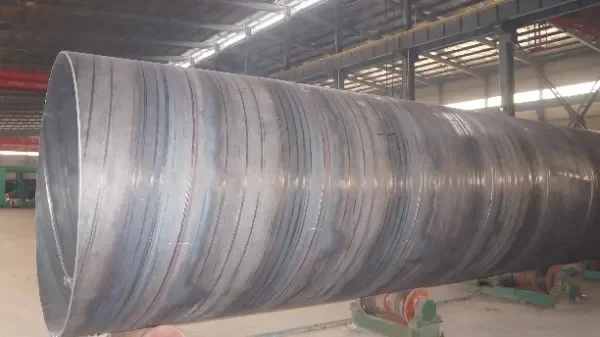How is spiral welded steel pipe produced?
Spiral welded steel pipe is a commonly used steel pipe product, widely used in petroleum, natural gas, water conservancy, construction, and other fields. Its production process is a complex process that requires the cooperation of various equipment and processes. Let's take a look at it in detail below.

1. Raw material preparation
The first step in the production of spiral steel pipes is to prepare raw materials. The most commonly used material for spiral steel pipes is hot-rolled steel coils. The coils are first quality checked and then sent to the slitting line where they are cut into narrow strips of the required width. The strip is then sent to an uncoiled which unwinds the strip and feeds it into the forming machine.
2. Coil
Plate coiling is the first and most critical step in the production of spiral-welded steel pipes. The plate rolling machine is a large-scale mechanical equipment that can roll the steel plate into a certain diameter and thickness to form a certain length of steel coil. The plate rolling speed and tension of the plate rolling machine need to be strictly controlled to ensure that the quality and size of the steel coil meet the requirements.
3. Pre-bending
Pre-bending is to round the ends of the coil for subsequent welding. The pre-bending machine usually adopts a three-roller structure, which can pre-bend the two ends of the steel coil into a certain radius.
4. Welding
Welding is the core link in the production of spiral-welded steel pipes. Welding machines usually use double-sided submerged arc welding technology, that is, welding is performed on both sides of the steel coil at the same time. During welding, parameters such as welding current, voltage, and welding speed need to be controlled to ensure the quality and strength of the weld.
5. Straightening
Straightening is to make the welded steel pipe reach a certain straightness and roundness. The straightening machine usually adopts a multi-roller structure, which can gradually straighten the steel pipe into a certain shape and size.
6. Cutting
Cutting is to cut the straightened steel pipe into a certain length of the product. The cutting machine usually adopts oxygen cutting or plasma cutting technology, which can cut the steel pipe into a certain length of products.
7. Rust removal and painting
Rust removal and painting are to protect the surface of the steel pipe from rust and corrosion. Rust removal usually adopts sandblasting or shot peening technology, which can remove the rust on the surface of the steel pipe. Spraying usually adopts spraying technology, which can spray a layer of anti-corrosion paint on the surface of the steel pipe.
8. Quality inspection and packaging
Quality inspection and packaging are the last steps in the production of spiral welded steel pipes. Quality inspection personnel need to check the size, quality, weld seam, surface, etc. of the steel pipe to ensure that the steel pipe meets the requirements. Packers need to pack steel pipes into wooden boxes or plastic bags for transportation and storage.
In short, the production process of spiral welded steel pipe is a complex process that requires the cooperation of various equipment and processes. Only under the premise of strictly controlling the quality and process of each link can we produce high-quality spiral welded steel pipes.
How is the spiral steel pipe pile produced?
The difference between spiral steel pipe pile and ordinary spiral steel pipe






